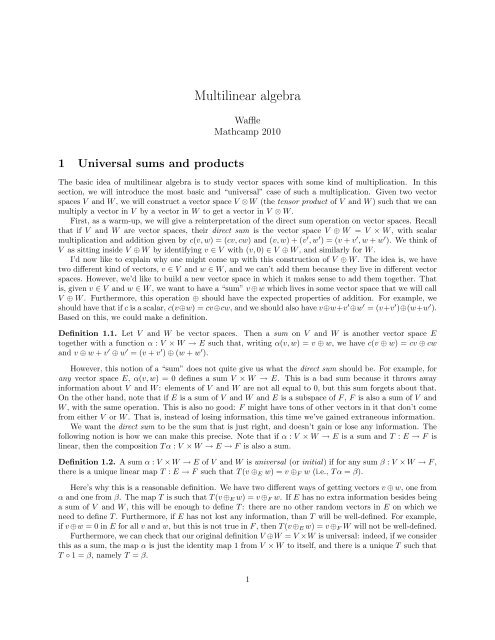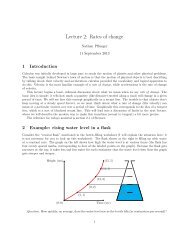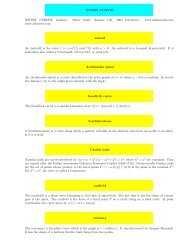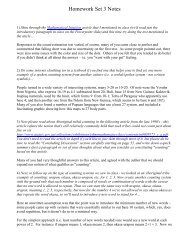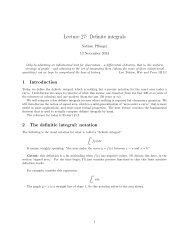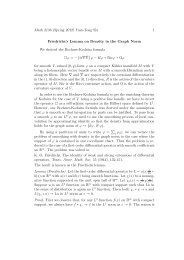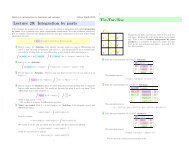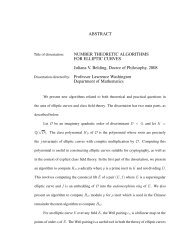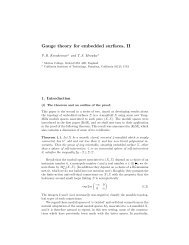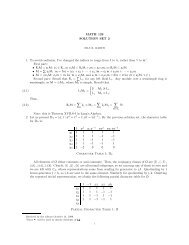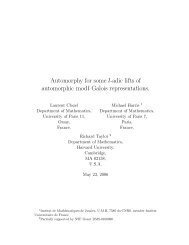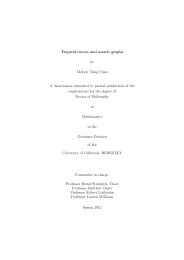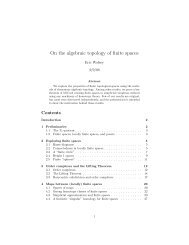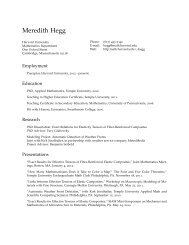Multilinear algebra
Multilinear algebra
Multilinear algebra
You also want an ePaper? Increase the reach of your titles
YUMPU automatically turns print PDFs into web optimized ePapers that Google loves.
1 Universal sums and products<br />
<strong>Multilinear</strong> <strong>algebra</strong><br />
Waffle<br />
Mathcamp 2010<br />
The basic idea of multilinear <strong>algebra</strong> is to study vector spaces with some kind of multiplication. In this<br />
section, we will introduce the most basic and “universal” case of such a multiplication. Given two vector<br />
spaces V and W , we will construct a vector space V ⊗ W (the tensor product of V and W ) such that we can<br />
multiply a vector in V by a vector in W to get a vector in V ⊗ W .<br />
First, as a warm-up, we will give a reinterpretation of the direct sum operation on vector spaces. Recall<br />
that if V and W are vector spaces, their direct sum is the vector space V ⊕ W = V × W , with scalar<br />
multiplication and addition given by c(v, w) = (cv, cw) and (v, w) + (v ′ , w ′ ) = (v + v ′ , w + w ′ ). We think of<br />
V as sitting inside V ⊕ W by identifying v ∈ V with (v, 0) ∈ V ⊕ W , and similarly for W .<br />
I’d now like to explain why one might come up with this construction of V ⊕ W . The idea is, we have<br />
two different kind of vectors, v ∈ V and w ∈ W , and we can’t add them because they live in different vector<br />
spaces. However, we’d like to build a new vector space in which it makes sense to add them together. That<br />
is, given v ∈ V and w ∈ W , we want to have a “sum” v ⊕ w which lives in some vector space that we will call<br />
V ⊕ W . Furthermore, this operation ⊕ should have the expected properties of addition. For example, we<br />
should have that if c is a scalar, c(v⊕w) = cv⊕cw, and we should also have v⊕w+v ′ ⊕w ′ = (v+v ′ )⊕(w+w ′ ).<br />
Based on this, we could make a definition.<br />
Definition 1.1. Let V and W be vector spaces. Then a sum on V and W is another vector space E<br />
together with a function α : V × W → E such that, writing α(v, w) = v ⊕ w, we have c(v ⊕ w) = cv ⊕ cw<br />
and v ⊕ w + v ′ ⊕ w ′ = (v + v ′ ) ⊕ (w + w ′ ).<br />
However, this notion of a “sum” does not quite give us what the direct sum should be. For example, for<br />
any vector space E, α(v, w) = 0 defines a sum V × W → E. This is a bad sum because it throws away<br />
information about V and W : elements of V and W are not all equal to 0, but this sum forgets about that.<br />
On the other hand, note that if E is a sum of V and W and E is a subspace of F , F is also a sum of V and<br />
W , with the same operation. This is also no good: F might have tons of other vectors in it that don’t come<br />
from either V or W . That is, instead of losing information, this time we’ve gained extraneous information.<br />
We want the direct sum to be the sum that is just right, and doesn’t gain or lose any information. The<br />
following notion is how we can make this precise. Note that if α : V × W → E is a sum and T : E → F is<br />
linear, then the composition T α : V × W → E → F is also a sum.<br />
Definition 1.2. A sum α : V × W → E of V and W is universal (or initial) if for any sum β : V × W → F ,<br />
there is a unique linear map T : E → F such that T (v ⊕E w) = v ⊕F w (i.e., T α = β).<br />
Here’s why this is a reasonable definition. We have two different ways of getting vectors v ⊕ w, one from<br />
α and one from β. The map T is such that T (v ⊕E w) = v ⊕F w. If E has no extra information besides being<br />
a sum of V and W , this will be enough to define T : there are no other random vectors in E on which we<br />
need to define T . Furthermore, if E has not lost any information, than T will be well-defined. For example,<br />
if v ⊕w = 0 in E for all v and w, but this is not true in F , then T (v ⊕E w) = v ⊕F W will not be well-defined.<br />
Furthermore, we can check that our original definition V ⊕W = V ×W is universal: indeed, if we consider<br />
this as a sum, the map α is just the identity map 1 from V × W to itself, and there is a unique T such that<br />
T ◦ 1 = β, namely T = β.<br />
1
However, while there should be a single definite direct sum of two vector spaces, it’s far from obvious<br />
that there is only one “universal sum.” However, it turns out that there is.<br />
Theorem 1.3. Let α : V × W → E and β : V × W → F be two universal sums. Then there is a unique<br />
isomorphism T : E → F such that T (v ⊕E w) = v ⊕F w.<br />
Proof. Since E is universal, there is a unique linear map T with the desired property; we just want to show<br />
that T is an isomorphism. We show this by constructing an inverse map S : F → E. Namely, because F is<br />
also universal, there is a unique map S : F → E such that S(v ⊕F w) = v ⊕E w.<br />
We want to show that S is the inverse of T , i.e. that ST is the identity map 1 : E → E and T S is<br />
1 : F → F . Note that ST (v⊕Ew) = S(v⊕F w) = v⊕Ew. That is, ST : E → E satisfies ST (v⊕Ew) = v⊕Ew.<br />
By universality of E, there is a unique map E → E with this property. But the identity map also has this<br />
property, so we must have ST = 1. The same argument shows that T S = 1.<br />
Thus in fact, this highly abstract definition of a “universal sum” is in fact well-defined (up to isomorphism)<br />
and gives a new definition of direct sum. It might seem silly to use such a complicated definition when we<br />
can just define V ⊕ W = V × W . However, in the case of tensor product, which we now turn to, there is no<br />
such simple concrete definition, at least without choosing a basis.<br />
Tensor products will be like direct sums, except for the operation of multiplication rather than addition.<br />
We need to write down some axioms that “multiplication” should satisfy, and then we can just copy the<br />
definition we made above.<br />
Definition 1.4. Let V and W be vector spaces. Then a product (or bilinear map) on V and W is another<br />
vector space E together with a function µ : V × W → E such that, writing µ(v, w) = v ⊗ w, we have<br />
c(v ⊗ w) = cv ⊗ w = v ⊗ cw, (v + v ′ ⊗ w = v ⊗ w + v ′ ⊗ w), and v ⊗ (w + w ′ ) = v ⊗ w + v ⊗ w ′ .<br />
Example 1.5. The “dot product” k n × k n → k defined by v · w = v1w1 + v2w2 + · · · + vnwn is a product.<br />
More generally, we can see that a function µ : k n × k m → k is a product if µ(v, w) is some polynomial in the<br />
coordinates of v and the coordinates of w, each term of which is of the form cjkvjwk for cjk a scalar.<br />
Definition 1.6. A product µ : V × W → E of V and W is universal (or initial) if for any product<br />
λ : V × W → F , there is a unique linear map T : E → F such that T (v ⊗E w) = v ⊗F w (i.e., T µ = λ).<br />
Theorem 1.7. Let µ : V × W → E and λ : V × W → F be two universal products. Then there is a unique<br />
isomorphism T : E → F such that T (v ⊗E w) = v ⊗F w.<br />
Proof. Exactly the same as Theorem 1.3<br />
We can thus define tensor products.<br />
Definition 1.8. The tensor product of two vector spaces V and W is the (unique up to isomorphism) vector<br />
space V ⊗ W equipped with a universal product V × W → V ⊗ W .<br />
But wait! There’s still a problem with this definition: how do we know that a universal product actually<br />
exists? For sums, we knew it existed because we could explicitly construct it, as just the cartesian product.<br />
For products, we will have to give an explicit construction to show existence as well, but it is much less<br />
simple. We will do this at the beginning of the next section.<br />
1.1 Exercises<br />
Exercise 1.1. Show that a sum α : V × W → E is equivalent to a pair of linear maps, one V → E and the<br />
other W → E. 1 (Hint: Consider α(v, 0) and α(0, w).)<br />
Exercise 1.2. For V and W vector spaces, write Hom(V, W ) for the set of all linear maps from V to W .<br />
1 By “equivalent”, we mean that there is a natural bijection between the set of sums V × W → E and the set of pairs of<br />
maps V → E and W → E.<br />
2
(a): Show that Hom(V, W ) is naturally a vector space.<br />
(b): Show that a product map V × W → E is equivalent to a linear map V → Hom(W, E).<br />
(c): Find a natural nontrivial product map Hom(V, W ) × V → W .<br />
Exercise 1.3. Show that 0 ⊗ 0 = 0, where 0 = {0} is the trivial vector space.<br />
Exercise 1.4. Show that the map µ : k ×k → k given by µ(a, b) = ab is a product. Is it a universal product?<br />
Exercise 1.5. We will do this in class tomorrow, but you can try to figure it out now if you want. Let<br />
V = k n and W = k m , and define a product µ : V × W → k nm by<br />
µ(v, w) = (v1w1, v1w2, . . . , v1wm, v2w1, . . . , v2wm, v3w1, . . . , vnwm).<br />
Show that this is a universal product, so k n ⊗ k m ∼ = k nm .<br />
3
2 Tensor products<br />
We begin with the result promised at the end of the previous section.<br />
Theorem 2.1. Any two vector spaces have a tensor product.<br />
Proof. Let V and W be vector spaces. Let E be the vector space of all formal linear combinations of symbols<br />
v ⊗ w where v ∈ V and w ∈ W . That is, an element of E is a finite sum ci(vi ⊗ wi), where the ci are<br />
scalars, vi ∈ V and wi ∈ W . Alternatively, E is a vector space with basis V × W , where we write the basis<br />
element coming from (v, w) as v ⊗ w.<br />
We now want to force the symbol ⊗ to represent a product. To do this, we let K be the subspace of E<br />
spanned by all elements of the form c(v ⊗ w) − cv ⊗ w, c(v ⊗ w) − v ⊗ cw, (v + v ′ ) ⊗ w − v ⊗ w − v ′ ⊗ w, and<br />
v ⊗ (w + w ′ ) − v ⊗ w − v ⊗ w ′ . That is, these are the elements such that if they were zero, that would say<br />
that ⊗ is a product. We then define V ⊗ W to be the quotient vector space E/K.<br />
We have a map µ : V × W → E → E/K = V ⊗ W where the first map sends (v, w) to v ⊗ w; we claim<br />
that this map is a universal product. First of all, it is a product: that’s exactly what modding out by K<br />
does. Now let λ : V × W → F be any other product. Note that since E and hence E/K is spanned by<br />
elements of the form v ⊗ w, there is at most one linear map T : V ⊗ W preserving the product. We thus<br />
want to show that one exists. We can first define a map ˜ T : E → F which sends v ⊗ w to v ⊗F w; this<br />
is well defined since {v ⊗ w} forms a basis for E. To turn ˜ T into our desired map T : E/K → F , we just<br />
need to show that K is contained in the kernel of ˜ T . But since ⊗F is a product, all the elements of K must<br />
become zero when you replace ⊗ with ⊗F , which is exactly what ˜ T does. Thus ˜ T (K) = 0 so we obtain a<br />
map T : E/K → F witnessing the universality of E/K.<br />
This constructions is explicit enough to tell us what an element of V ⊗ W looks like: it is a linear<br />
combination civi ⊗ wi. However, two such linear combinations can be equal, and they are equal exactly<br />
when they are forced to be equal by the fact that ⊗ is a product.<br />
Let’s now give a more concrete description of tensor products.<br />
As a first example of how we can actually compute tensor products, let’s let W = 0, the trivial vector<br />
space containing only 0. Then in V ⊗ 0, for any v ∈ V we have an element v ⊗ 0, and these will span all of<br />
V ⊗ 0. Now note that for any scalar c, c(v ⊗ 0) = v ⊗ (c · 0) = v ⊗ 0. But the only way this can happen for<br />
an element of a vector space is if v ⊗ 0 = 0! Indeed, if for example we let c = 2, we get 2(v ⊗ 0) = v ⊗ 0 so<br />
subtracting v ⊗ 0 from both sides gives v ⊗ 0 = 0.<br />
This means that every element of V ⊗ 0 is 0, i.e. V ⊗ 0 = 0.<br />
OK, let’s look at a more interesting example. Let W = k, the field of scalars, considered as a 1-dimensional<br />
vector space (if you are not comfortable thinking about vector spaces over general fields, you can assume<br />
k = R). To understand V ⊗ k, we need to understand products µ : V × k → E. Given such a product, for<br />
each v ∈ V we have an element µ(v, 1) ∈ E. Furthermore, for any other c ∈ k, by bilinearity (i.e., being<br />
a product), µ(v, c) = cµ(v, 1), so these elements µ(v, 1) determine µ. Also, bilinearity says that µ(v, 1) is<br />
linear as a function of v. Indeed, µ is bilinear iff µ(v, 1) is linear in v.<br />
Thus we have found that a product on V × k is the same thing as a linear map on V . But by definition,<br />
a product on V × k is the same thing as a linear map on V ⊗ k. Thus we should get the following.<br />
Proposition 2.2. For any V , V ⊗ k ∼ = V .<br />
Proof. To prove this rigorously, we have to give a product µ : V × k → V and show that it is universal. The<br />
only natural product to write down is µ(v, c) = cv, where the right-hand side is scalar multiplication in V .<br />
This is universal by the discussion above: given any other product λ : V × k → F , we get a map V → F by<br />
just sending v to λ(v, 1), and this preserves the product since it sends µ(v, c) = cv to λ(cv, 1) = λ(v, c).<br />
Finally, there is one more property that we need to compute general tensor products.<br />
Proposition 2.3. For any U, V , and W , (U ⊕ V ) ⊗ W ∼ = (U ⊗ W ) ⊕ (V ⊗ W ). The isomorphism sends<br />
(u ⊕ v) ⊗ w to (u ⊗ w) ⊕ (v ⊗ w).<br />
4
Proof. First, we define a map T : U ⊕ (V ) ⊗ W → (U ⊗ W ) ⊕ (V ⊗ W ) by saying<br />
T ((u ⊕ v) ⊗ w) = (u ⊕ w) ⊗ (v ⊕ w).<br />
This gives a well-defined linear map by the definition of the tensor product, since the right-hand side is<br />
bilinear in u ⊕ v and w<br />
On the other hand, we can also define a map S : (U ⊗ W ) ⊕ (V ⊗ W ) → U ⊕ (V ) ⊗ W by<br />
S((u ⊕ w1) ⊗ (v ⊕ w2)) = (u ⊕ 0) ⊗ w1 + (0 ⊕ v) ⊗ w2.<br />
This is a well-defined linear map by a similar analysis. Finally, we have T S = 1 and ST = 1, so they are<br />
inverse isomorphisms.<br />
With this, we can understand the tensor product of any two vector spaces. For example, let W = k ⊕k, a<br />
2-dimensional vector space. Then for any V , V ⊗ W ∼ = (V ⊗ k) ⊕ (V ⊗ k) = V ⊕ V . More generally, iterating<br />
this argument shows that V ⊗ W is a direct sum of copies of V , one for each dimension of W . Let’s make<br />
this more precise.<br />
Theorem 2.4. Let {ei} be a basis for V and {fj} be a basis for W . Then {ei ⊗ fj} is a basis for V ⊗ W .<br />
In particular, dim(V ⊗ W ) = dim(V ) dim(W ).<br />
Proof. We can verify this directly by showing explicitly that a bilinear map is uniquely determined by saying<br />
where each (ei, fj) gets sent. Indeed, for any v ∈ V we can write v = ciei and for any w ∈ W we can write<br />
w = djfj, and then we must have µ(v, w) = µ( ciei, djfj) = <br />
i,j cidjµ(ei, fj). On the other hand,<br />
given any values of µ(ei, fj), we can see that the expression above for µ(v, w) gives a well-defined bilinear<br />
map, by uniqueness of the representation v = ciei and w = djfj. This says that a linear map out of<br />
V ⊗ W is uniquely determined by saying where each ei ⊗ fj goes, i.e. {ei ⊗ fj} is a basis.<br />
However, this also follows from the results we have proven already. Namely, giving a basis {ei} of V is<br />
the same as giving an isomorphism kn → V which sends (1, 0, 0, . . . ) to e1, (0, 1, 0, . . . to e2, (0, 0, 1, . . . ) to<br />
e3, and so on. Thus our bases give isomorphisms V ∼ = kn and W ∼ = km , and the “distributivity” property<br />
(Proposition 2.3) together with k ⊗ k ∼ = k gives that kn ⊗ km ∼ = knm . Chasing through exactly what the map<br />
in Proposition 2.3 is, we can see that the isomorphism V ⊗ W ∼ = kn ⊗ km ∼ = knm corresponds to picking the<br />
basis {ei ⊗ fj} for V ⊗ W .<br />
Note that we could have just taken Theorem 2.4 as the definition of the tensor product. However, this<br />
would have been very awkward because it depends on a choice of a basis, and it’s not at all obvious that<br />
you could make it independent of the basis. This is why we made our abstract definition.<br />
2.1 Exercises<br />
Exercise 2.1. Show that V ⊗ W ∼ = W ⊗ V naturally. (Hint: You can prove it picking a basis or using<br />
the universal property. However, if your isomorphism involves a basis, you should show that if you picked a<br />
different basis, you would still get the same isomorphism (this is part of what “naturally” should mean).)<br />
Exercise 2.2. Show that (U ⊗ V ) ⊗ W ∼ = U ⊗ (V ⊗ W ).<br />
Exercise 2.3. Let k = R, and consider C as a vector space over R. Show that for any R-vector space V ,<br />
C ⊗ V can naturally be thought of as a vector space over C, whose dimension over C is the same as the<br />
dimension of V over R. (C ⊗ V is called the complexification of V , and should be thought of as V but with<br />
the scalars formally extended from R to C.)<br />
Exercise 2.4. Let k[x] be the set of polynomials in a variable x with coeffients in k; this is a vector space<br />
over k. Show that k[x] ⊗ k[y] ∼ = k[x, y] via f(x) ⊗ g(y) ↦→ f(x)g(y), where k[x, y] is the vector space of<br />
polynomials in two variables x and y.<br />
5
Exercise 2.5. Give a definition of a trilinear map U × V × W → E (it should be something like “linear in<br />
all three variables simultaneously”). Show that U ⊗ V ⊗ W (parenthesized in either way by Exercise 2.2)<br />
is the universal vector space with a trilinear map from U × V × W (the same way V ⊗ W is the universal<br />
vector space with a bilinear map from V × W ).<br />
Exercise 2.6. Generalize Exercise 2.5 by replacing 3 by n: define an n-multilinear map V1×V2×· · ·×Vn → E,<br />
and show that V1 ⊗V2 ⊗· · ·⊗Vn is the universal vector space with an n-multilinear map V1 ×V2 ×· · ·×Vn →<br />
V1 ⊗ V2 ⊗ · · · ⊗ Vn.<br />
Exercise 2.7. Define a product map of abelian groups to be a map µ : A × B → C satisfying µ(a + a ′ , b) =<br />
µ(a, b) + µ(a ′ , b) and µ(a, b + b ′ ) = µ(a, b) + µ(a, b ′ ).<br />
(a): Show that for any two abelian groups A and B, a universal product A × B → A ⊗ B exists. (Hint:<br />
Imitate the proof of Theorem 2.1.)<br />
(b): Show that Z/2 ⊗ Z/3 = 0. (Hint: Show that any product Z/2 × Z/3 → C is identically 0.)<br />
6
3 Exterior products and determinants<br />
In this section, we will look at a specific notion of multiplication, namely one that relates to area and volume.<br />
The basic idea is as follows. Given two vectors v and w, we can form the parallelogram that they span,<br />
and write v ∧ w for something we think of as the “area” of the parallelogram. This is not quite the usual<br />
notion of area, however, because we want to think of it not just as a single number but as also having a<br />
“two-dimensional direction” (the same way a single vector v both has a size and a direction). That is, if<br />
we had a parallelogram pointing in a “different direction”, i.e. in a different plane, we would think of it as<br />
different.<br />
Let’s write down some properties this v ∧ w ought to have. Scaling v or w scales the parallelogram, and<br />
thus ought to scale its area. That is, for scalars c, we should have (cv) ∧ w = c(v ∧ w) = v ∧ (cw). This<br />
suggests that the operation ∧ ought to be bilinear. Another property of ∧ is that for any vector v, v ∧ v<br />
should be 0: if both vectors are pointing in the same direction, the “parallelogram” is just a line segment<br />
and has no area.<br />
As it turns out, these two properties are the only properties we really need.<br />
Definition 3.1. Let V be a vector space. Then the exterior square 2 (V ) is the quotient of V ⊗ V by the<br />
subspace spanned by the elements v ⊗ v for all v ∈ V . We write v ∧ w for the image of v ⊗ w under the<br />
quotient map V ⊗ V → 2 (V ).<br />
Let’s try to understand what this vector space 2 (V ) actually looks like. First, there is a very important<br />
formal consequence of the fact that v ∧ v = 0 for all v. Namely, if we apply this to a sum v + w, we get<br />
0 = (v + w) ∧ (v + w) = v ∧ v + v ∧ w + w ∧ v + w ∧ w = v ∧ w + w ∧ v.<br />
Thus for any v and w, v ∧ w = −w ∧ v. That is, as a “multiplication”, this ∧ operation is “anticommutative”<br />
(or “alternating”).<br />
We can now see what 2 (V ) looks like if we pick a basis {ei} for V . We know that {ei ⊗ ej} is a basis<br />
for V ⊗ V . However, in 2 (V ), ei ∧ ei = 0 and ei ∧ ej = −ej ∧ ei, so 2 (V ) can be spanned by just the<br />
elements ei ∧ ej for which i < j. Seeing that all these are indeed linearly independent is a bit trickier.<br />
Theorem 3.2. Suppose {ei} is a basis for V . Then {ei ∧ ej}i j, and<br />
T (ei ⊗ ei) = 0. We want to show that T gives a map S : 2 (V ) → E; it suffices to show that T (v ⊗ v) = 0<br />
for all v ∈ V . Let v = ciei; then<br />
v ⊗ v = cicjei ⊗ ej = <br />
c 2 i ei ⊗ ei + <br />
cicj(ei ⊗ ej + ej ⊗ ei).<br />
i<br />
We thus see that T (v ⊗ v) = 0. Hence T gives a map S : 2 (V ) → E which sends ei ∧ ej to eij. Since<br />
the eij are linearly independent in E by construction, this implies that the ei ∧ ej (for i < j) are linearly<br />
independent, and hence a basis.<br />
One thing to note about 2 (V ) is that not every element is of the form v ∧ w. That is, not every “area<br />
vector” is just an area in some plane; it can also be a sum of areas in different planes. For example, if {ei}<br />
is a basis, then e1 ∧ e2 + e3 ∧ e4 cannot be simplified to a single v ∧ w.<br />
We can use the same idea to generalize from area to volume, or even n-dimensional volume.<br />
7<br />
i
Definition 3.3. Let r ∈ N and V be a vector space. Then r (V ) is the quotient of V ⊗ · · · ⊗ V (with r<br />
factors) by the subspace spanned by all tensors v1 ⊗ · · · ⊗ vn for which two of the vi are the equal. The<br />
exterior <strong>algebra</strong> (V ) is the direct sum r(V r ).<br />
We think of an element of r (V ) as some sort of “r-dimensional volume vector”. Note that 0(V ) = k<br />
and 1 (V ) = V , the former because the “empty” tensor product is k (since V ⊗ k = V for any V ). The<br />
same argument as for r = 2 shows the following.<br />
Theorem 3.4. Suppose {ei} is a basis for V . Then {ei1 ∧ ei2 ∧ · · · ∧ eir}i1
4 More on Determinants; Duality<br />
Let’s see that this definition of determinant we gave agrees with other definitions you may have seen. If<br />
V = k2 <br />
a b<br />
is 2-dimensional (with basis {e1, e2} and we represent T as a matrix , then det(T ) is supposed<br />
c d<br />
to be ad − bc. Now T (e1) = ae1 + ce2 and T (e2) = be1 + de2, so we have<br />
2 T (e1∧e2) = T (e1)∧T (e2) = (ae1+ce2)∧(be1+de2) = ab(e1∧e1)+ad(e1∧e2)+bc(e2∧e1)+bd(e2∧e2) = (ad−bc)(e1∧e2).<br />
In general, a similar calculation shows that the determinant of a matrix (aij) is given by a sum of products<br />
± a iσ(i) where σ is a permutation of the numbers 1, . . . , n and the sign is given by the sign of the<br />
permutation σ.<br />
Many important properties of determinants are easy to understand from this definition. First of all, it is<br />
manifestly independent of any choice of basis. Second, it is clear that det(ST ) = det(S) det(T ), since n (ST )<br />
is just the composition n (S) n(T ), which is just multiplication by det(T ) followed by multiplication by<br />
det(T ). We can then use this to prove the other extremely useful property of determinants:<br />
Theorem 4.1. Let V be finite-dimensional and T : V → V be linear. Then T is invertible iff det(T ) = 0.<br />
Proof. First, if T T −1 = I, then det(T ) det(T −1 ) = det(I) = 1 so det(T ) = 0. Conversely, suppose T is not<br />
invertible. Then for some nonzero v, T (v) = 0. Pick a basis {ei} for V such that e1 = v. Then<br />
so det(T ) = 0.<br />
det(T )e1 ∧ · · · ∧ en =<br />
n T (e1 ∧ · · · ∧ en) = T (e1) ∧ · · · ∧ T (en) = 0 ∧ · · · ∧ T (en) = 0,<br />
Let’s now change gears and look at another construction, closely related to tensor products. We will<br />
assume all vector spaces are finite-dimensional from now on.<br />
Definition 4.2. Let V and W be vector spaces. Then we write Hom(V, W ) for the set of linear maps from<br />
V to W . This is a vector space by defining addition and scalar multiplication pointwise.<br />
More concretely, if we pick bases for V and W , we can think of Hom(V, W ) as a vector space of matrices:<br />
if V is n-dimensional and W is m-dimensional, a linear map V → W can be represented as an n × m matrix<br />
(assuming we pick bases). It follows that the dimension of Hom(V, W ) is nm.<br />
We also know another way to form a vector space from V and W that is nm-dimensional, namely the<br />
tensor product V ⊗W ! It follows that Hom(V, W ) is isomorphic to V ⊗W . However, we could ask whether it<br />
is natural to think of them as being isomorphic–that is, whether we can write down an isomorphism between<br />
them without choosing bases.<br />
To understand this, we will specialize to the case W = k. In that case, V ⊗ W = V ⊗ k can naturally be<br />
identified with V , and Hom(V, W ) = Hom(V, k) is called the dual of V and written V ∗ . An element of V ∗<br />
is a linear function α that eats a vector and V and gives you a scalar.<br />
Given a basis {ei} for V , we get a basis {α i } (the dual basis) for V ∗ as follows: let α i be the linear map<br />
such that α i (ei) = 1 and α j (ei) = 0 if j = i. This completely defines αi since {ei} is a basis, and we can<br />
easily see that these are linearly independent (because ( ciα i )(ej) = cj, so if ciα i = 0 then ci = 0 for<br />
all i). Finally, the α i span all of V ∗ since given any α ∈ V ∗ , we can show that α = α(ei)αi.<br />
Thus given a basis {ei} for V , we obtain an isomorphism T : V → V ∗ by defining T (ei) = α i . However,<br />
for this to be a “natural” isomorphism, it should not depend on which basis we chose. Unfortunately, it<br />
does!<br />
Example 4.3. Let V = k 2 , and let {e1, e2} be the standard basis, with dual basis {α 1 , α 2 }. A different<br />
basis for V is given by f1 = e1 and f2 = e1 +e2; call the dual basis to this {β 1 , β 2 }. Now β 1 (e1) = β 1 (f1) = 1<br />
and β 1 (e2) = β 1 (f2 − f1) = −1, so β 1 = α 1 − α 2 . Similarly, β 2 = α 2 .<br />
9
Now the isomorphism T : V → V ∗ given by the basis {e1, e2} is T (e1) = α 1 , T (e2) = α 2 . However, the<br />
isomorphism S : V → V ∗ given by the basis {f1, f2} is S(f1) = β 1 , S(f2)β 2 , and hence<br />
S(e1) = S(f1) = β 1 = α 1 − α 2 ,<br />
S(e2) = S(f2 − f1) = β 2 − β 1 = 2α 2 − α 1 .<br />
Thus S and T are quite different, showing that the isomorphism V → V ∗ very much depends on what basis<br />
you use!<br />
Thus we should not think of V and V ∗ as being the same; we can only identify them if we’ve chosen a<br />
basis. However, we can identify V with its double dual!<br />
Theorem 4.4. Let V be a (finite-dimensional) vector space and v ∈ V . Let ˜v : V ∗ → k be defined by<br />
˜v(α) = α(v). Then v ↦→ ˜v is an isomorphism from V to (V ∗ ) ∗ .<br />
Proof. It is straightforward to check that ˜v : V ∗ → k is a linear map, so ˜v ∈ (V ∗ ) ∗ . Similarly, it is<br />
straightforward to check that the map v → ˜v is linear. Thus we only need to check that it is an isomorphism.<br />
If we pick a basis {ei} for V , let {α i } be the dual basis for V ∗ and let {fi} be the basis of (V ∗ ) ∗ dual to<br />
{α i }. We claim that fi = ˜ei; it follows that our map is an isomorphism. Indeed, ˜ei(α i ) = αi(ei) = 1 and<br />
˜ei(α j ) = α j (ei) = 0 if i = j, exactly the definition of the dual basis {fi} of {α i }.<br />
Thus we should think of V ∗ as different from V (even though they have the same dimension), but V ∗∗<br />
is the same as V .<br />
Let’s now turn back to the general question of how Hom(V, W ) and V ⊗ W might be related. In the case<br />
W = k, we found that Hom(V, k) = V ∗ and V ⊗ k = V were of the same dimension but not the same. For<br />
general W , we have a similar situation.<br />
Theorem 4.5. Define a map T : V ∗ ⊗ W → Hom(V, W ) by T (α ⊗ w)(v) = α(v)w (remember α(v) ∈ k is a<br />
scalar, so we can multiply it with w). Then T is an isomorphism, and so V ∗ ⊗ W ∼ = Hom(V, W ) in a natural<br />
(basis-independent) way.<br />
Proof. Pick a basis {ei} for V , the dual basis {αi } for V ∗ , and a basis {fj} for W . A basis for Hom(V, W ) is<br />
given by the matrices with all entries 0 except for the ijth entry 1; this is exactly the linear map βi j defined<br />
by βi j (ei) = fj and βi j (ek) = 0 if k = i. We claim that T (αi ⊗ fj) = βi j , and hence T sends a basis to a basis<br />
and is an isomorphism.<br />
To check this, we must just evaluate T (αi ⊗ fj) on each ek and see that it agrees with βi j . But T (αi ⊗<br />
fj)(ek) = αi (ek)fj, which is fj if i = k and 0 otherwise, which is exactly what we want.<br />
Note that the coefficients of a map A : V → W with respect to the basis {βi j } is exactly the entries of<br />
the matrix representing A. Thus if we think of a map A : V → W as an element of V ∗ ⊗ W , its coefficients<br />
with respect to the basis {αi ⊗ fj} are exactly its matrix entries.<br />
4.1 Exercises<br />
Exercise 4.1. Given a linear map T : k 3 → k 3 given by a matrix<br />
⎛<br />
⎝<br />
a11 a12 a13<br />
a21 a22 a23<br />
a31 a32 a33<br />
⎞<br />
⎠, show that<br />
det(T ) = a11a22a33 + a12a23a31 + a13a21a32 − a11a23a32 − a13a22a31 − a12a21a33.<br />
Exercise 4.2. Given a linear map T : k n → k n given by a matrix with entries aij (1 ≤ i, j ≤ n), show that<br />
det(T ) = <br />
ɛ(σ) <br />
aiσ(i), σ∈Sn<br />
where the product is over all permutations σ of {1, . . . , n} and ɛ(σ) = ±1 is the sign of the permutation.<br />
10<br />
i
Exercise 4.3. Define a map T : V ∗ ⊗ W ∗ → (V ⊗ W ) ∗ by T (α ⊗ β)(v ⊗ w) = α(v)β(w) (so T (α ⊗ β) is a<br />
map V ⊗ W → k). Show that T is an isomorphism. (Hint: Use bases.)<br />
Exercise 4.4. Write the identity map I : V → V as an element of V ⊗ V ∗ , in terms of a basis {ei} for V<br />
and the dual basis {α i } on V ∗ .<br />
Exercise 4.5. Let µ : V × V → k be a bilinear map. We say µ is nondegenerate if for any v ∈ V , there<br />
exists a w ∈ V such that µ(v, w) = 0. Show that a nondegenerate bilinear map µ gives an isomorphism<br />
T : V → V ∗ defined by T (v)(w) = µ(v, w).<br />
Exercise 4.6. Let {ei} be a basis for V and define µ(civi, divi) = cidi (the dot product with respect<br />
to this basis). Show that µ is a nondegenerate bilinear map V × V → k, and show that the associated<br />
isomorphism V → V ∗ sends the basis {ei} to its dual basis.<br />
Exercise 4.7. Given a linear map T : V → W , you can get a linear map T ∗ : W ∗ → V ∗ by defining<br />
T ∗ (α)(v) = α(T (v)) (so T ∗ (α) is a map V → k). We can think of T as an element of W ⊗ V ∗ and T ∗ as an<br />
element of V ∗ ⊗ W ∗∗ = V ∗ ⊗ W . Show that if we identify W ⊗ V ∗ with V ∗ ⊗ W by just swapping the order<br />
of tensors, then T is the same as T ∗ . (Hint: Use bases.)<br />
11
5 Traces and TQFT<br />
Another way that Hom(V, W ) is related to tensor products is the following. Given f ∈ Hom(V, W ) and v ∈ V ,<br />
we can evaluate f on v to get an element f(v) ∈ W . This is a bilinear map Hom(V, W )×V → W , so it gives a<br />
linear map ev : Hom(V, W )⊗V → W . In particular, for W = k, we get a map tr : V ⊗V ∗ → k. Furthermore,<br />
if we identify Hom(V, W ) with V ∗ ⊗W = W ⊗V ∗ as in Theorem 4.5, ev : Hom(V, W )⊗V = W ⊗V ∗ ⊗V → W<br />
is just given by pairing up the V ∗ and V using tr. That is ev(w ⊗ v ∗ ⊗ v) = v ∗ (v)w (for v ∗ ∈ V ∗ ). This can<br />
be seen by the map used in Theorem 4.5: an element of W ⊗ V ∗ maps V to W by pairing the element of v<br />
with the V ∗ part of the tensor product.<br />
More generally, there is a composition map Hom(U, V ) ⊗ Hom(V, W ) → Hom(U, W ) which composes two<br />
linear maps. Writing these Hom’s in terms of tensor products and duals, this is a map U ∗ ⊗ V ⊗ V ∗ ⊗ W →<br />
U ∗ ⊗ W . A similar analysis to the analysis above shows that this map is just given by pairing up the V and<br />
V ∗ in the middle: we compose linear maps by sending u ∗ ⊗ v ⊗ v ∗ ⊗ w to v ∗ (v)u ∗ ⊗ w.<br />
Let’s now see what happens when we let W = V . We then have Hom(V, V ) = V ⊗ V ∗ , and there is a<br />
map tr : Hom(V, V ) = V ⊗ V ∗ → k, a map which takes a linear map T : V → V and gives a scalar. This is<br />
called the trace tr(T ) of T .<br />
You may have seen the trace of a matrix defined as the sum of its diagonal entries. This definition is really<br />
quite mystifying: why on earth would you take the diagonal entries (as opposed to some other collection of<br />
entries) and add them up? Why on earth would that be independent of a choice of basis?<br />
On the other hand, our definition is manifestly independent of a choice of basis and is very naturally<br />
defined: it’s just the natural evaluation map on V ⊗ V ∗ . We can furthermore check that this agrees with<br />
the “sum of the diagonal entries” definition.<br />
Example 5.1. Let V have basis {e1, e2} and let {α 1 , α 2 } be the dual basis of V ∗ . Let T : V → V have<br />
<br />
a b<br />
matrix<br />
c d<br />
matrix with ij entry 1 and all other entries 0. Thus T is given by<br />
. We want to write down T as an element of V ⊗ V ∗ . Recall that ei ⊗ α j corresponds to the<br />
ae1 ⊗ α 1 + be1 ⊗ α 2 + ce2 ⊗ α 1 + de2 ⊗ α 2 .<br />
Now the trace just takes these tensors and evaluates them together, so ei ⊗ α j goes to 1 if i = j and 0<br />
otherwise. Thus tr(T ) ends up being exactly a + d, the sum of the diagonal entries. The same argument<br />
would generalize to n × n matrices for any n.<br />
Besides basis-invariance, one of the most important properties of traces is the following.<br />
Theorem 5.2. Let S, T : V → V be linear maps. Then tr(ST ) = tr(T S).<br />
Proof. Write S and T as elements of V ∗ ⊗V , say S = v ∗ ⊗v and T = w ∗ ⊗w (actually, S and T will be linear<br />
combinations of things of this form, but by linearity of everything we can treat each term separately). Then<br />
recall that we compose linear maps by “pairing up the vectors in the middle”, so ST will be v ∗ (w)w ∗ ⊗ v, so<br />
tr(ST ) = v ∗ (w)w ∗ (v). On the other hand, T S = w ∗ (v)v ∗ ⊗ w and tr(T S) = w ∗ (v)v ∗ (w). But multiplication<br />
of scalars is commutative, so these are the same!<br />
Let’s now look more closely at how duals and tensor products interact with linear maps. First, note that<br />
an element u of a vector space U is just the same thing as a linear map T : k → U, namely the linear map<br />
such that T (1) = u. Thus in showing that elements of V ∗ ⊗ W = Hom(V, W ) are the same as maps V → W ,<br />
we’ve shown that maps V → W are the same as maps k → V ∗ ⊗ W . We can think of this as “moving V to<br />
the other side” by dualizing it. In fact, this works more generally.<br />
Theorem 5.3. Let U, V , and W be (finite-dimensional) vector spaces. Then linear maps U ⊗ V → W are<br />
naturally in bijection with linear maps U → V ∗ ⊗ W = Hom(V, W ).<br />
Proof. Given T : U ⊗ V → W , we can define ˜ T : U → Hom(V, W ) by ˜ (T )(u)(v) = T (u ⊗ v). Conversely,<br />
given ˜ T : U → Hom(V, W ), we can define T : U ⊗ V → W by T (u ⊗ v) = ˜ T (u)(v). Clearly these two<br />
operations are inverse to each other.<br />
12
That is, a V on one side of a linear map is equivalent to a V ∗ on the other side. Another way to see this<br />
is that the set of maps U ⊗ V → W is<br />
Hom(U ⊗ V, W ) = (U ⊗ V ) ∗ ⊗ W = U ∗ ⊗ V ∗ ⊗ W = U ∗ ⊗ (V ∗ ⊗ W ) = Hom(U, V ∗ ⊗ W )<br />
(using Exercise 4.3 to say (U ⊗ V ) ∗ = U ∗ ⊗ V ∗ ).<br />
As yet another way to understand this correspondence, we can take ˜ T : U → V ∗ ⊗ W and define a linear<br />
map 1 ⊗ ˜ T : V ⊗ U → V ⊗ V ∗ ⊗ W by 1 ⊗ ˜ T (v ⊗ u) = v ⊗ ˜ (T )(u). We can then compose this with the map<br />
V ⊗ V ∗ ⊗ W → k ⊗ W = W which just evaluates the V ∗ factor on the V factor (i.e., the trace map) to get a<br />
map T : U ⊗ V = V ⊗ U → V ⊗ V ∗ ⊗ W → W . Chasing through all the definitions (perhaps using a basis)<br />
shows that this is the same operation as the one used above.<br />
We can understand this operation in another way by drawing pictures of lines. Unfortunately, I don’t<br />
know how to make such pretty pictures in L ATEX, so I can’t provide these pictures in these notes.<br />
5.1 Exercises<br />
Exercise 5.1. Verify that if you think of maps U → V and V → W as elements of V ∗ ⊗ U and W ∗ ⊗ V ,<br />
then you compose maps via the linear map W ∗ ⊗ V ⊗ V ∗ ⊗ U which sends w ∗ ⊗ v ∗ ⊗ v ⊗ u to v ∗ (v)w ∗ ⊗ u.<br />
Exercise 5.2. Show that the dual of the trace map V ⊗ V ∗ → k is the map k ∗ = k → V ∗ ⊗ V = Hom(V, V )<br />
which sends 1 to the identity I : V → V . (Here we are take the dual of a linear map as in Exercise 4.7.)<br />
Exercise 5.3. Show that there is a natural (basis-free) isomorphism r (V ∗ ) ∼ = ( r(V )) ∗ . (Hint: Find a<br />
way to “wedge together” r elements of V ∗ to get a map from r (V ) → k, and use a basis to show that this<br />
gives an isomorphism r (V ∗ ) → ( r(V )) ∗ .<br />
Exercise 5.4. Let V and W be vector spaces and let S : k → V ⊗ W and T : W ⊗ V → k be maps such that<br />
the compositions V = k ⊗V S⊗1<br />
→ V ⊗W ⊗V 1⊗T<br />
→ V ⊗k = V and W = W ⊗k 1⊗S<br />
T ⊗1<br />
→ W ⊗V ⊗W → k ⊗W = W<br />
are both the identity maps (here 1 ⊗ S, for example, means the map 1 ⊗ S(v ⊗ c) = v ⊗ S(c)). Show<br />
that there is an isomorphism W ∼ = V ∗ such that when you identify W with V ∗ , S(1) is the identity map<br />
I ∈ Hom(V, V ) = V ⊗ V ∗ and T : V ∗ ⊗ V → k is the trace map.<br />
13


